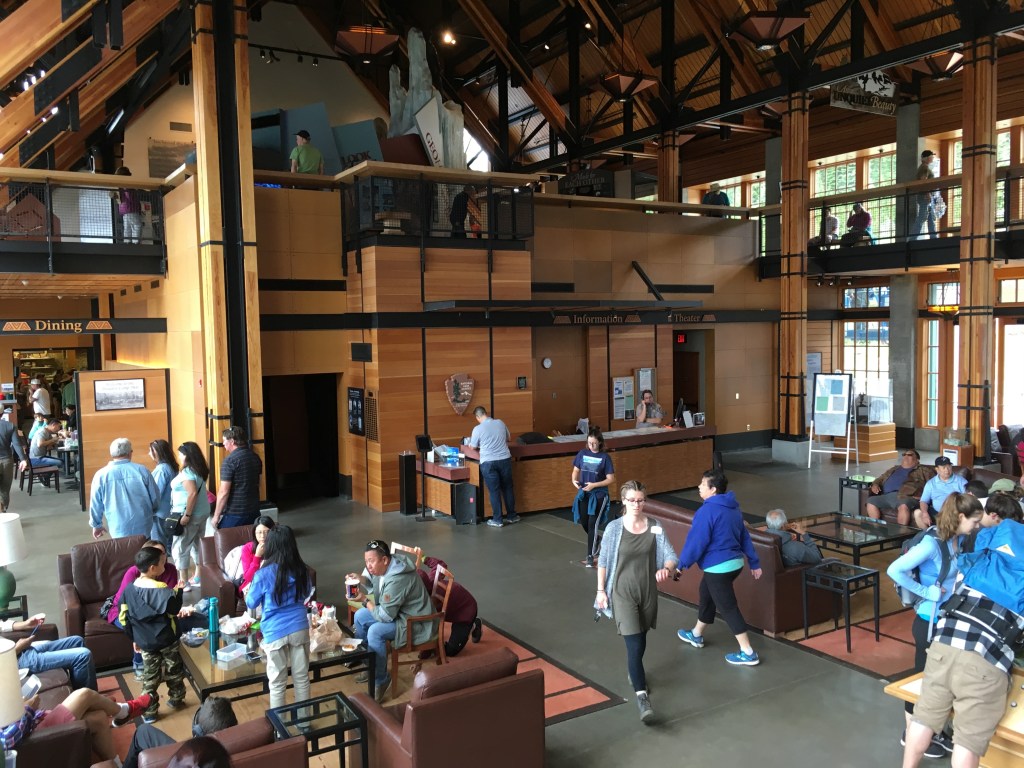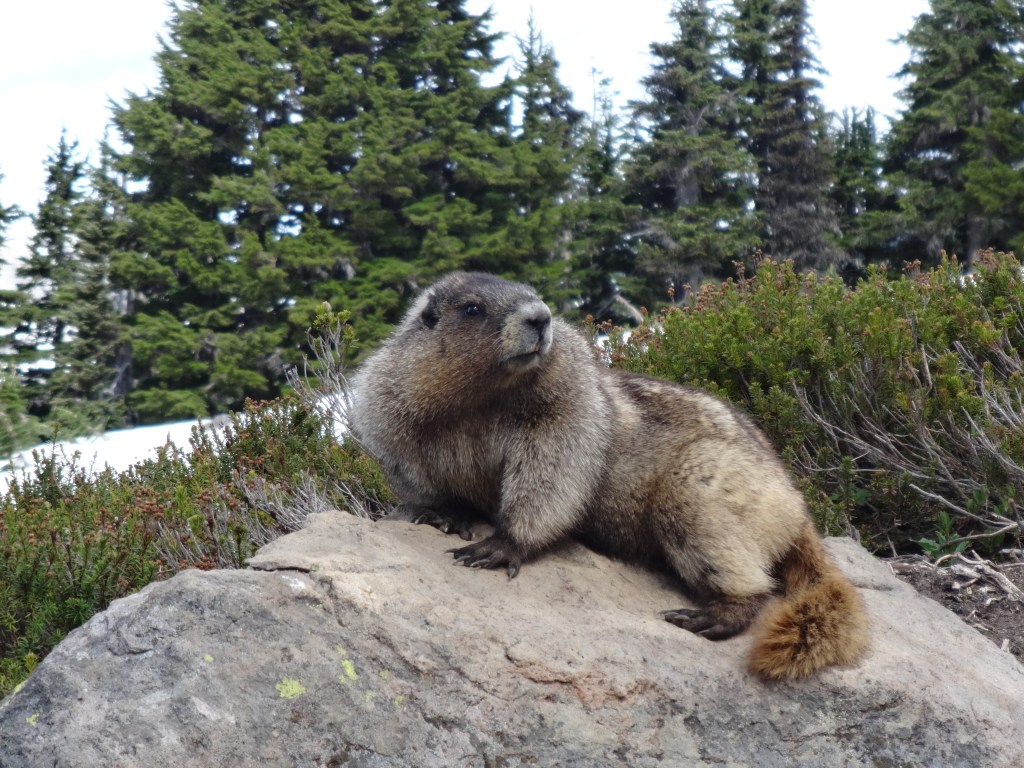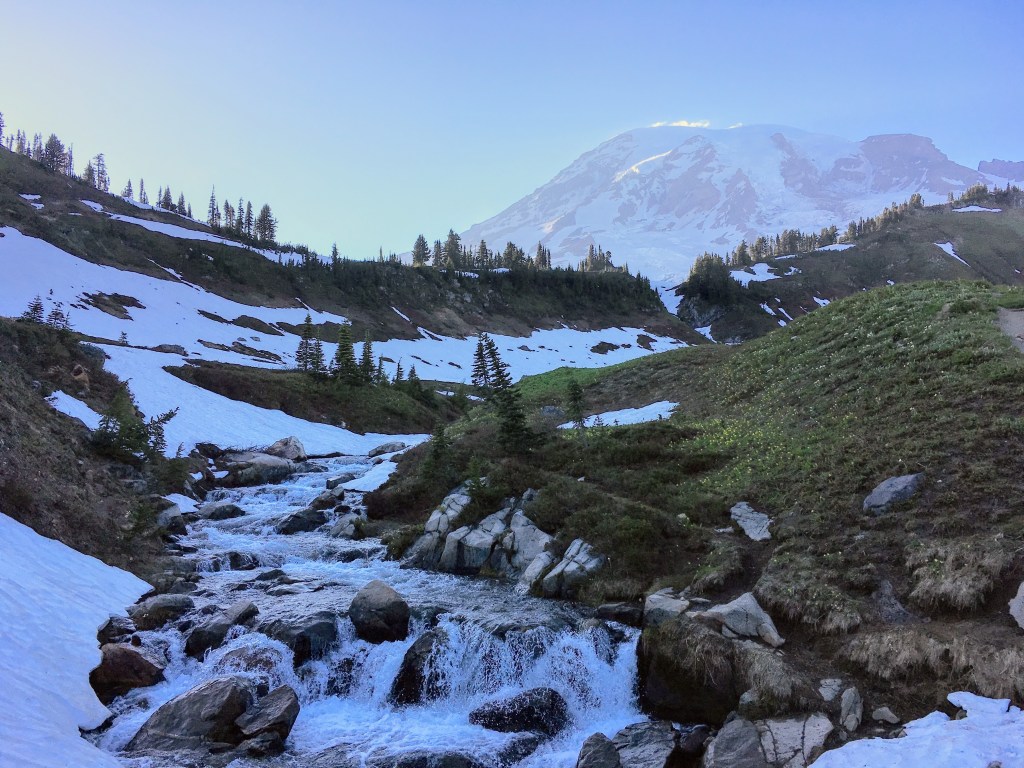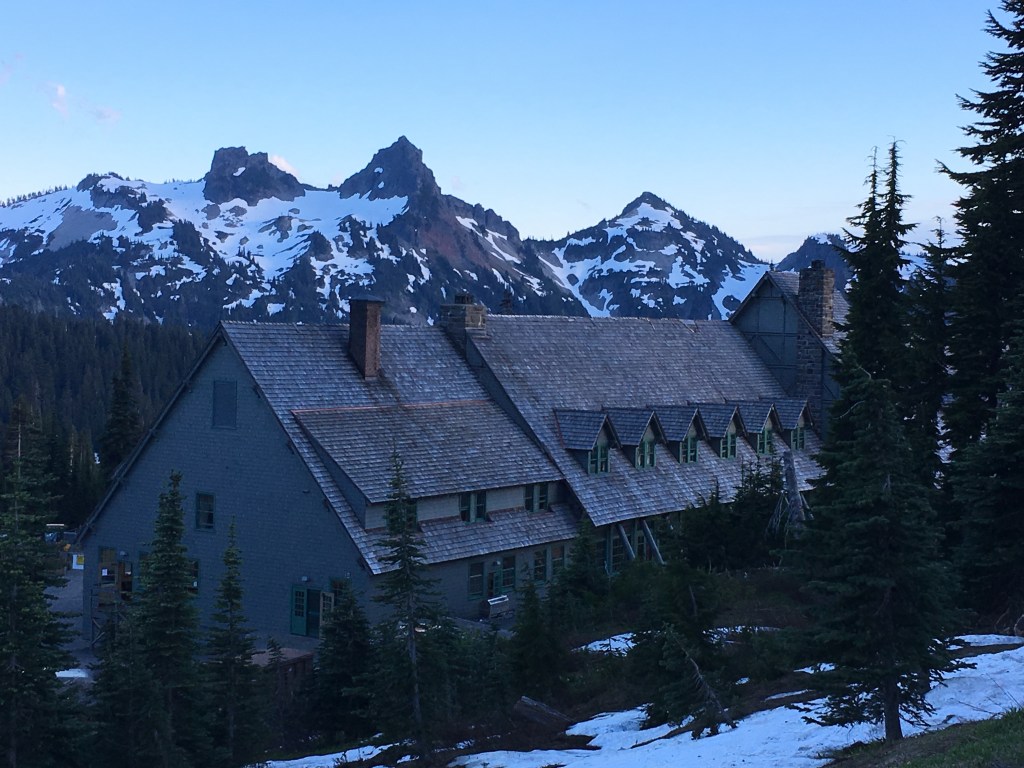“Of all the fine mountains which like beacons, once blazed along the Pacific Coast, Mount Rainier is the noblest.” – John Muir
Cars were backed up to get into this park. I could see just a little bit up the forested road to the entrance gate. There a large wooden sign hung down from a rustic pine log which laying there, propped up by other pines on either side, had constructed an archway- a portal into the park. Its letters were all upper-case, bold, and carved simply into the sign. The grooves painted white displayed “MT. RAINIER NATIONAL PARK.”
This was a top tier national park, our nation’s third behind Yellowstone and Yosemite, created in 1899 by President William McKinley signing a bill passed by Congress. This park is named and centered around one mountain peak, but deservingly so. MountRainier is a giant at 14,411 ft. It is visible throughout most of the state of Washington and has the most glaciers than any other peak in the contiguous United States with a whopping total of 26 glaciers. We had seen this mountain much earlier in the day, traveling from the Olympic peninsula around Tacoma. It was a magnificent bold giant standing in the distance. Over the course of hours we noticed it growing bigger as we drew closer to it. Now we were at the mountain’s base about to enter the National Park!
Once officially inside, passing beneath the enormous sign and log beams, flashing my park pass and getting my park map, the road immediately began to gradually ascend. We were on our way to the Paradise village area of the park on the side of the mountain. There in Paradise was a visitor center, a lodge, and a network of trails. On our ascent through the thick rich forest, I stopped at one point to hop out onto a short path to a platform overlook nestled between the dark pines. There at the platform’s edge I beheld the amazing wonder of Nisqually Glacier tearing down the mountainside. Up until this point this was one, if perhaps not the most, impressive view in nature. It was my first time observing a glacier- the breaking ripples of ice, deep grooves, sharp edges rolling over and tearing down the mountainside, but all seemingly still. It was action frozen in time to my eyes. I observed a depth of snow and ice I had never witnessed before, and as the glacier spread down the mountains I saw the enormous gorge it had created over many years, carving away at the mountainside. Although there was a plaque labeling Nisqually Glacier, I believe, after considering the park map, I was also looking at two other glaciers in the same view: Wilson Glacier and Von Trump Glacier. It’s hard to differentiate between all the glaciers as they run so close to each other and at times converge.

Van Trump Glacier was named after Philemon Beacher Van Trump, an American pioneering mountaineer who made the first recorded summit of Mount Rainier. He wrote: “That first true vision of the mountain, revealing so much of its glorious beauty and grandeur, its mighty and sublime form filling up nearly all of the field of direct vision, swelling up from the plain and out of the green forest till its lofty triple summit towered immeasurably above the picturesque foothills, the westering sun flooding with golden light and softening tints its lofty summit, rugged sides and far-sweeping flanks – all this impressed me so indescribably, enthused me so thoroughly, that I then and there vowed, almost with fervency, that I would some day stand upon its glorious summit, if that feat were possible to human effort and endurance.”
Unlike P.B. Van Trump, I would not be summiting Mount Rainier, but I shared in his admonishment of the mountain, and around its base and on its mountainside I would experience many of its rich wonders. With just one up-close and unobstructed view, it was love at first sight!
“Let’s go!”
We got back in the car and continued on our way to Paradise. It was about twenty miles of meandering parkway that climbed and switch-backed up to 5,400 feet. At Paradise the mountain peak was on full display. The terrain had leveled to an extent to allow the construction of the large visitor center, lodge, and ample parking. I was anxious to get outside. Breaking my usual protocol, I took to a trail before even watching the park film. We’d do that later.
Zach and I started on Nisqually Vista Loop. It’s supposed to be a casual paved loop, but pavement was only visible for a few yards, the rest was buried under multiple feet of snow. We slid, ran, trudged, fell, and laughed our way around the loop. The mountain peak with its great and scarring glaciers came into view every once in a while through the lodge-pole pine trees, and at the trail’s furthest reach we had an unobstructed view of the mountain while on enormous continuous icescape that stretched up the mountainside connecting to the glacier’s ripples. Although it was summer, and I was wearing gym shorts, this place had so much ice and so much snow, that I felt so far in the North, in an extreme arctic landscape. The one thing I had to overlook, however, was the air temperature, as it wasn’t very cold out at all.

At one point on our hike we heard water rushing. We paused and tried to figure out where it was coming from, just to come to the realization that it was beneath us. A mountain stream was flowing beneath the snow. We then encountered a few cavities in the snow just wide enough to fit a body. So taking turns we both hopped down, our boots landing in the shallow stream, and we raised our hands up out of the hole, taking each other’s photo trying for the illusion that we had been buried in snow.


When we completed the loop, we went into the visitor center. It was quite large, with lots of ample space for sitting in its spacious lobby beneath a combination of timber and iron framework that supported a pointed ceiling. Its walls were almost entirely glass, giving way to much light, especially with all the sun reflecting off the snowy landscape outside. The visitor center had museum exhibits on the park on its second floor which was a combination of loft and balcony. We went into the theater to see the park film, of which I remember nothing, probably because this mountain did not need a film to speak for it. It was so grandiose and commanding of attention, that any measly park film was greatly overshadowed. After the park film, we had a quick bite to eat in the cafeteria there in the visitor center, and then we were back on the trails to visit Myrtle Falls.

Our short hike to Myrtle Falls was lovely. I think typically it’s only about a half mile walk one way on pavement, but it was a bit more of hike for use trudging over snow banks, perhaps wandering off the official route at times, observing the many marmots lounging and flopping around, and admiring the alpine meadows full of blooming glacier lilies. We concluded our hike at around two miles. Here we weren’t exactly above the tree line, for small groupings of pines could be seen at the fringe edges of the meadows, but largely we were above the trees in rolling meadows of the mountainside. Despite it being a sunny day with a nice rich blue sky, we were cast in the shadow of a foothill, a ridge on the mountainside. As we approached the falls, we saw it sprawling down into a Edith Creek Gorge, chillingly cold in the shadows, water falling and tumbling over water, streams cascading upon protruding rocks behind the many paths of the water falling. It was a rather simple, but beautiful water fall, as from the creek it sort of bloomed as it fell, branching out in many streams down into the gorge. Just above the falls was where the trail led to a pedestrian polebridge perhaps about thirty feet long, made of timber from the forest. Behind the view of the falls, the bridge, the creek, the snow banks, and the flower laden meadows, was the towering Mount Rainier. Its highest reaches were adorned with the silver lining from the sun peeking out from behind some adjoining ridge with a cast stretching just far enough to barely reach the top of the mountain.



With all the movement of water sprawling in every which way, falling, and cascading; and glacier lilies feeding off the melting snow, the marmots flopping around, the tourists delighting on meandering paths and trudging through snow, I thought about how rich of a place this was. I also considered how we were up high on the mountainside, and below was a rich forest, full of more waterfalls and streams, thick pines, and forest growth; with bears, mountain lions, bobcats, foxes, minks, and all the other wild animals and tweeting birds of the forest. This mountain provided so much life! It was truly rich. I’ve written about how we can liken mountains to people. There are so many different types of mountains which exhibit the different kinds of influence and character of which a person can behold.


I started this summer’s journey in the Mojave desert where the mountains surrounding are largely dry, harsh, and bare. They lack the richness of a place like this. They do not support an abundance of life. There is no richness of the forest like on this mountainside.
Mount Rainier with its glaciers melting feeds the forest around it. Not only can I liken this mountain to Wheeler Peak, being bold and unwavering, but this mountain is also very life-giving. Like a nurse log, it provides rich nutrients, giving life to the forest around it through its supply of melting ice, and its delicate balance of sunlight and shade. However, unlike a nurse log, this mountain is not dead. It’s alive. I say it’s alive on the basis that it is an active volcano. Thus here lies the message: though nurse logs provide great insight showing us how even when we are dead, we can provide life to future generations, we provide life to others while still alive as well, just like Mount Rainier. I know this may seem maybe even more obvious than the nurse log analogy, but I think we ought to be aware that we should not over focus on our efforts of what we can leave behind while ignoring who we are and what we can do in the present. We have the immeasurable benefit and advantage of our present life. We can use it to take hold of the life books of others and write into them powerful influence, whether it be in the form of encouragement, instruction, giving… Whatever it is we do, we do not do it alone, as to do so would be in vain. We do everything through the power of Christ in our lives. We may be the mountains that provide for the richness of life around us, but who provides the weather to bring snow upon our mountains? Who causes the sun to shine on our side? Who causes the water to melt and fall? Who brings the flowers to bloom? This makes me think of Scripture, of all the mentions of bearing fruit spiritually. To bear fruit spiritually is to be like Mount Rainier. Look at the life flourishing around it. There is evidence of God at work here, and there would be much more to consider and write about here in regards to the powerful symbolism of Mount Rainier.
When we were done with our hike we went back to Paradise Inn next to the visitor center. It was an inn of beautiful rustic National Park architecture style, cozy and woodsy, with wood logs beams stretching in every direction, an “A frame” roof, dangling native american style lanterns, a blazing fireplace, and inviting little nooks to relax in. It was a great sanctuary from he snow and he evening cold outside. There I bought some tea and wrote some postcards.


Leaving the lodge, getting ready to head down the mountainside to our site at Cougar Rock Campground, a beautiful sunset was on display with deep rich pinks and purples. The sunset reflected off the snow on the mountain peaks, providing colorful stretches of snow. Wow! It was a sunset so perfectly reflective of a mountain so rich in life. Its colors were so vibrant and deep. Most of the tourists were gone. The area was silent and serene. I had to pause a moment to take it in. John Muir knew what he was saying when he said Mount Rainier was the noblest of peaks.
What Kind of Mountain are you?

If you enjoyed reading this, check out my book “Still, Calm, and Quiet“
Check out my previous entry here: “The Mountain Goats of Hurricane Ridge”
Visit www.joshhodge.com
